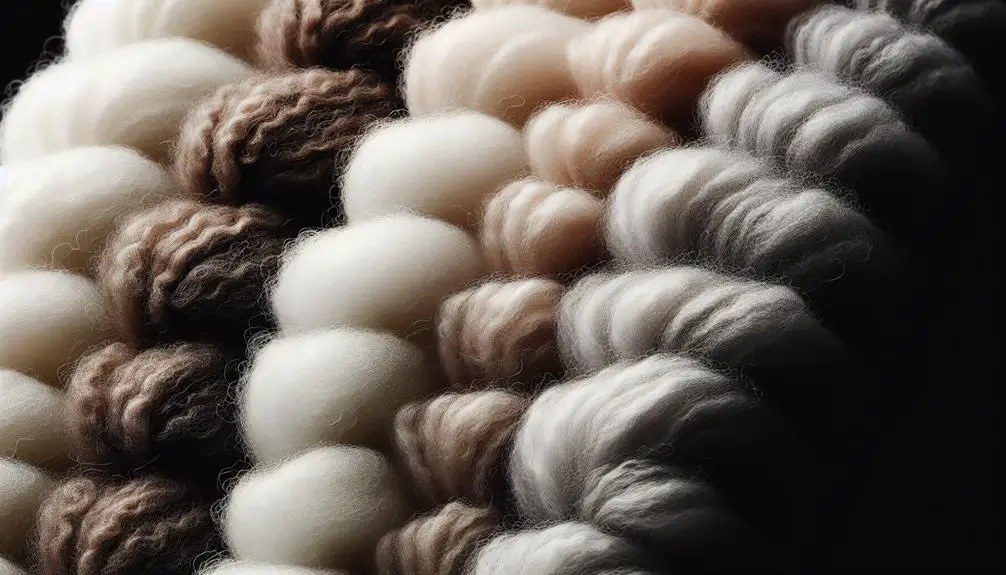Wool is a natural fabric prized for its warmth and insulation. It's commonly used in clothing items like sweaters, coats, and socks. If you want to know more about the types of wool fabrics, their properties, uses, and even the production process, keep exploring the world of wool!
Table of Contents
Key Takeaways
- Wool is a natural fabric made from the fleece of sheep.
- Common types include merino, cashmere, and lambswool.
- Known for its insulation, moisture-wicking, and durability properties.
- Used in various clothing items like sweaters, coats, and suits.
- Production involves spinning, weaving, dyeing, and finishing processes.
Types of Wool Fabrics
When delving into the world of wool fabrics, it's essential to understand the various types available. Merino wool, known for its softness, is a popular choice in clothing and home textiles. Worsted wool, on the other hand, is made from longer fine fibers, resulting in a lighter, smoother, and more durable fabric compared to woolen fabrics spun from shorter fibers.
Among the common fabric types are boiled wool, boucle, and tweed. Boiled wool undergoes a special process that shrinks and tightens the fabric for added warmth and wind resistance. Boucle fabric is characterized by looped or curled fibers, creating a textured and cozy feel. Tweed, a classic choice, features a rough, woolen fabric often woven with mixed, colorful yarns for a distinctive look.
Each fabric type, whether boiled wool, boucle, or tweed, offers unique textures and styles, allowing for versatile garment options suitable for different preferences and occasions.
Wool Fabric Properties
Derived from the hair of various animals like sheep, goats, llamas, camels, and rabbits, wool fabric possesses exceptional properties that make it a versatile and highly sought-after material.
Wool is renowned for its insulating properties, effectively trapping heat and keeping you warm during colder seasons. This natural fiber isn't only durable but also biodegradable, breaking down in soil within a year and making it an environmentally friendly choice.
The breathability of wool fabric guarantees comfort by regulating body temperature and wicking away moisture, preventing that clammy feeling. Common types of wool include merino, cashmere, and lambswool, each offering unique qualities suitable for different garments.
Due to its durability and natural properties, wool is commonly used in a variety of clothing items such as gloves, hats, socks, sweaters, suits, and coats. Its ability to provide warmth, durability, and eco-friendliness makes wool a favored choice for many seeking quality and sustainability in their garments.
Wool Fabric Production Process
I'll introduce the points related to the wool fabric production process, covering aspects such as wool fiber characteristics, spinning, and weaving techniques.
As well as dyeing and finishing methods commonly used in the industry.
These key elements shed light on the intricate steps involved in transforming raw wool fibers into the versatile fabric we use in various textiles and garments.
Understanding these processes is vital for appreciating the craftsmanship and skill required to create high-quality wool fabrics.
Wool Fiber Characteristics
Wool fiber characteristics play an essential role in the wool fabric production process, influencing its quality and performance in various applications. Wool fibers are known for their unique properties that make them highly desirable for textiles and garments. Below is a table highlighting key characteristics of wool fibers:
| Characteristic | Description |
|---|---|
| Warmth | Provides excellent insulation |
| Breathability | Allows moisture to be absorbed and evaporated |
| Durability | Resistant to tearing and wrinkling |
Understanding these characteristics is vital for the production process, including spinning and dyeing, to make sure the final wool fabric meets the desired standards for different uses. Wool's versatility makes it a preferred choice in a wide range of applications.
Spinning and Weaving
Beginning the intricate process of creating wool fabric involves skilled artisans spinning and weaving wool fibers into yarn for a variety of applications. Wool fibers, which have been carded into long strands, are carefully spun to create yarn that serves as the foundation for various woolen products. Skilled individuals play an essential role in ensuring the quality and consistency of the yarn during this process.
Once the yarn is spun, it can then undergo post-production processes like fulling and crabbing to further enhance its durability and appearance. Weaving comes into play after spinning, where the yarn is interlaced to form the fabric structure. Together, spinning and weaving are fundamental steps in the production of high-quality wool fabrics.
Dyeing and Finishing
In the wool fabric production process, dyeing and finishing play vital roles in enhancing the color, texture, and quality of the final product. Dyeing involves adding color to the wool fabric using natural or synthetic dyes like indigo, while finishing processes such as brushing, shearing, or pressing help achieve desired textures and appearances.
These finishing treatments can improve the wool fabric's softness, shine, and overall look, making it more appealing for various uses. Techniques like fulling, which shrinks and densifies the fabric through agitation, enhance its durability and texture.
The dyeing and finishing stages are essential for achieving the desired color, texture, and quality of the wool fabric.
Benefits of Wool Fabric
I want to highlight the amazing benefits of wool fabric.
Wool is fantastic for keeping you warm in cold weather, thanks to its exceptional insulation properties.
Additionally, it's great at wicking away moisture to keep you comfortable, and its longevity guarantees that your wool garments will last a long time.
Warmth and Insulation
Wrapped in wool fabric, one can experience unparalleled warmth and insulation, thanks to its natural crimp that effectively traps heat close to the body. Wool's high specific thermal resistance makes it an excellent choice for cold weather, ensuring you stay cozy even in the chilliest conditions. Its moisture absorption properties allow for comfort during various outdoor activities, keeping you warm and dry. Additionally, wool is breathable, providing ventilation while still offering insulation, making it a versatile option for different climates. The insulating properties of wool fabric make it a popular and reliable choice for winter clothing, guaranteeing both comfort and protection from the cold.
| Insulating Properties | Thermal Resistance | Moisture Absorption |
|---|---|---|
| High | Excellent | Efficient |
Moisture-Wicking Properties
Utilizing its natural moisture-wicking properties, wool fabric efficiently absorbs moisture from the skin, ensuring dryness and comfort in various conditions. This ability to absorb moisture allows wool to regulate body temperature effectively, keeping the wearer dry and cozy.
Wool can absorb up to 30% of its weight in moisture without feeling damp, making it an excellent choice for high-performance clothing during outdoor activities. The structure of wool fibers enables the efficient transport of moisture, preventing sweat build-up and odor.
Whether engaging in sports or simply enjoying the outdoors, the natural moisture-wicking properties of wool fabric make it a dependable option for those seeking comfort and performance in their clothing choices.
Durability and Longevity
With its remarkable durability and longevity, wool fabric stands out as a reliable choice for long-lasting clothing options. Wool fibers possess natural elasticity, allowing them to maintain their shape and resist wrinkles, ultimately enhancing the fabric's longevity.
The inherent resilience of wool makes it highly resistant to wear and tear, ensuring that garments retain their quality even with frequent use. Wool fabric's durability is further reinforced by its ability to bounce back from compression and stretching, guaranteeing lasting performance.
Popular Wool Fabric Uses
Wool fabric finds extensive use in a variety of applications ranging from outerwear to activewear due to its exceptional durability and insulating properties. It's commonly seen in outerwear, formal suits, sweaters, hats, gloves, and accessories, making it a versatile choice for various garment types. The insulating properties of wool help in retaining body heat, making it ideal for cold weather apparel. Additionally, wool's moisture-wicking capabilities make it a preferred material for activewear, ensuring comfort during physical activities by regulating body temperature and keeping sweat away from the skin.
Fine wool fabrics are often chosen for skin-contact garments due to their flame-retardant qualities and long-lasting wear. While wool may be more expensive than cotton and many synthetic fabrics, its unique benefits justify the cost, leading to its popularity in a wide range of consumer and industrial applications. The diverse utility of wool fabrics showcases their adaptability and effectiveness in different contexts.
Environmental Impact of Wool Fabric
The environmental impact of wool fabric is an essential aspect to ponder in today's world.
Sustainable practices such as responsible breeding and reduced chemical use are crucial for minimizing harm to ecosystems.
Wool Fabric Sustainability
Amidst concerns over environmental impact, sustainability in wool fabric production is a crucial focus for the industry. When considering wool fabric sustainability, several key points come to light:
- Certifications such as the Responsible Wool Standard (RWS) and Woolmark play a significant role in ensuring both quality and environmental responsibility.
- Australia, China, and the United States are major players in global wool production, collectively accounting for a significant portion of the market share.
- Sustainable practices are essential in the wool industry to combat issues like soil degradation, water pollution, and chemical use.
- Upholding ethical standards and promoting sustainable practices are crucial to mitigating the environmental impacts associated with wool production.
Wool Fabric Animal Welfare
Considering the impact of wool fabric production on animal welfare sheds light on its environmental implications. Sustainable wool production prioritizes the humane treatment of sheep and other animals involved in providing wool. Ethical production practices guarantee minimal environmental harm while promoting animal well-being. Responsible standards such as the Responsible Wool Standard (RWS) emphasize humane treatment, sustainable land management, and environmental stewardship.
Supporting ethical wool production not only contributes to sustainable practices but also helps to reduce negative environmental impacts. By focusing on the welfare of animals in the wool production process, we can work towards more sustainable and environmentally friendly practices within the industry, ensuring that ethical standards are met and upheld.
Wool Fabric Cost Factors
When determining the cost of wool fabric, one must consider various factors such as the type of wool, fiber quality, and production techniques. Factors influencing the cost of wool fabric include:
- The type of wool used, like Merino, Cashmere, or rare types such as Vicuña, impacting cost due to scarcity and demand.
- The quality of fibers, with premium options like Australian Merino wool commanding higher prices for their superior quality.
- The origin of wool, with Australian Merino known for its high quality affecting the price.
- Processing techniques, such as superwash technology for durability, influencing the final cost of the wool fabric.
Understanding these factors can help consumers appreciate the pricing differences in wool fabrics and make informed decisions based on their preferences and budget.
Wool Fabric Certification Guide
A Wool Fabric Certification Guide helps consumers identify ethically sourced and high-quality wool products. Certifications like the Responsible Wool Standard (RWS) and Woolmark promote sustainable production practices and promote transparency in the wool industry. The RWS certification focuses on humane treatment of sheep and sustainable wool production, while the Woolmark certification guarantees the authenticity and quality of wool products. By looking for these certifications, consumers can make informed choices about supporting ethical sourcing and sustainable practices in the production of wool fabric.
Sustainable wool production practices are essential in reducing the environmental impact of the industry, aiming to minimize water usage and chemical pollutants. Certification programs like RWS and Woolmark play an essential role in upholding these standards and fostering ethical practices globally. Choosing wool fabrics with these certifications not only ensures high quality but also supports a more sustainable and transparent supply chain for wool products.
Notable Wool Fabric Types
Merino wool stands out as one of the softest and finest wool types, commonly utilized in activewear and base layers.
Among the notable wool fabric types are:
- Cashmere wool: Luxuriously soft and lightweight, ideal for high-end fashion items but requiring delicate care.
- Alpaca wool: Hypoallergenic, water-resistant, and sustainable, offering excellent thermal regulation and durability.
- Mohair wool: Known for its strength, resilience, and wrinkle resistance, often used in suits and coats for its luster.
- Camel wool: Insulating and lightweight, durable and long-lasting, commonly found in luxury garments due to its natural shades.
Each of these wool types brings unique qualities to the table, catering to different needs in the world of fashion and textile production. From the softness of cashmere to the durability of camel wool, these fibers are prized for their luxurious feel and versatility in creating high-quality garments.
Global Wool Fabric Production
Leading the global wool fabric production industry, Australia contributes 25% of the world's wool output, with China closely following at 18%. The United States plays a significant role, accounting for 17% of global wool production. New Zealand, known for its crossbred wool varieties, stands as the third-largest wool producer worldwide.
Additionally, Turkey and the United Kingdom are major players in the global wool fabric production industry. These countries collectively drive the majority of wool fabric production globally, each bringing its unique expertise and specialization to the market.
The distribution of wool production among these key players highlights the diverse sources of high-quality wool fabrics available worldwide. Understanding the contributions of Australia, China, the United States, New Zealand, Turkey, and the United Kingdom is essential for grasping the scale and significance of global wool fabric production. Each country's distinct approach and focus contribute to the richness and variety of wool fabrics accessible on a global scale.
Main Manufacturers of Wool Fabric
In the domain of wool fabric production, key manufacturers from different countries contribute greatly to the global market.
- Australia: As the largest producer of wool fabric globally, Australia accounts for a substantial 25% of the world's wool production, setting a significant benchmark in the industry.
- China: Following closely behind, China showcases its substantial manufacturing capacity by producing 18% of the world's wool fabric, solidifying its position as a major player in the market.
- United States: With a 17% contribution to the global output, the United States plays a significant role in wool fabric production, adding diversity to the industry.
- New Zealand: Specializing in high-quality crossbred wool, New Zealand stands as the third-largest producer of wool fabric, offering excellence in various applications.
These countries, along with Turkey and the United Kingdom, collectively shape the landscape of wool fabric production, each bringing unique strengths and contributions to the global market.
Frequently Asked Questions
What Type of Fabric Is Wool?
Wool is a natural fiber sourced from animals like sheep, goats, and rabbits. It is a versatile fabric known for warmth and durability. Different types include Merino, Cashmere, Mohair, Alpaca, and Angora wool, each with unique characteristics.
What Is Wool Considered?
Wool, a natural fiber from animals like sheep, is revered for its insulating properties, perfect for winter wear. It's renewable and eco-friendly. Animals are sheared annually for their well-being, ensuring sustainable fiber. Wool is widely used in various clothing pieces for warmth and durability.
Is Wool Considered Cotton?
I must clarify that wool is not considered cotton. Wool is a natural fiber sourced from animals like sheep, goats, and alpacas. It stands out for its warmth, insulation, and moisture-wicking properties, making it ideal for winter wear.
What Is an Example of Wool?
An example of wool is merino, known for its softness and breathability. Cashmere, from Kashmir goats, is another luxurious type. Alpaca wool is hypoallergenic and water-resistant. Mohair offers luster and resilience. Camel wool is insulating and durable.
- The “Wet Powder on Dry Fabric” Tie-Dye Technique - July 14, 2025
- The “Dry Powder on Wet Fabric” Tie-Dye Technique - July 14, 2025
- How to Blend Colors Seamlessly in an Ombre Dye - July 14, 2025






